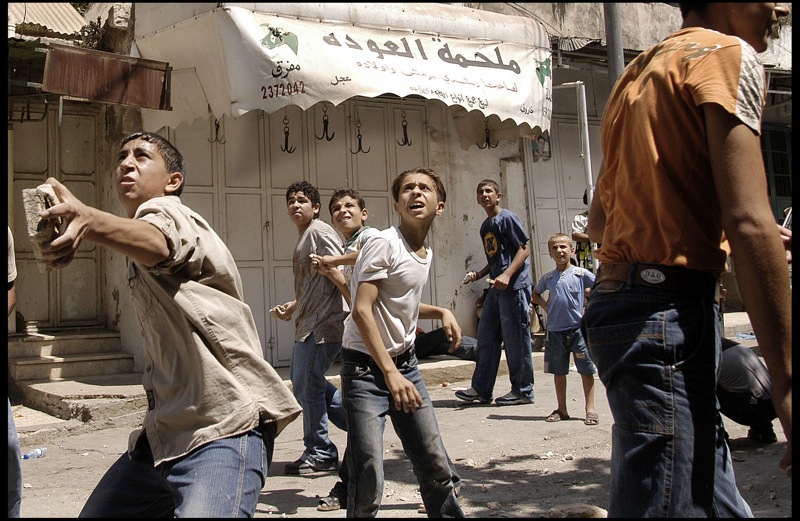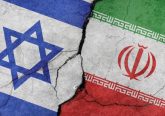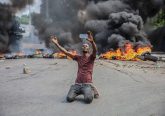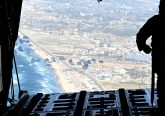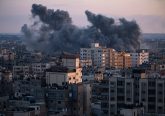As I am sitting here writing this contribution at 8:50 in the morning, I can already hear signs of the relentless fighting that has been going on for over ten days around Rachel’s Tomb in Bethlehem: Soldiers shooting tear gas canisters, military jets are flying over the area, ambulances rushing to the scene and hundreds of impatient drivers waiting to cross the area honking without let-up. Riots had kicked off in the area in response to the current dispute between Israeli Jews and Arabs about the administration of the Temple Mount in Jerusalem. The Muslim religious site is administered by Jordan and Jews are allowed to visit but not to pray there. Increased Jewish visits in recent times have raised suspicions that Israel is attempting to change this status quo, which Israel denies.
Since then, Palestinian youth have been going out every day, confronting Israeli soldiers on Hebron Road, the long highway which connects several Palestinian cities in the southern part of the West Bank with Jerusalem. The streets are empty in the late evenings and early mornings, but the traces of the day’s street battles leave no doubt as to how tense the situation in the city really is. Tear gas is still in the air, burnt objects lie around and the pavement has turned charcoal black.
It is just one of the many signs that commentators worldwide believe may mark the beginning of a Third Intifada or Palestinian uprising. The violence over the past weeks has been more intense than at any time after the Second Intifada of 2001. Neither Jews nor Arabs freely travel in Jerusalem these days. Repeated knife attacks on Jewish Israelis in public spaces drive people to shun public transportation, to avoid marketplaces and to carry heavy weaponry to thwart potential attacks.
Meanwhile, the Arabs of Jerusalem have been placed under increased scrutiny. Over the past few days I have been observing how Arab and Muslim passers-by are approached by border police for identification and questioning – undoubtedly a humiliating experience that increases ethnic tensions and shows that the government is taking action to control this difficult situation.
But increased scrutiny and humiliation are not the only consequences of the recent wave of terrorist attacks for Arab Israelis and Palestinians. When I make my way towards the checkpoint – around the corner from Rachel’s Tomb – I stop people on the street to ask whether it is safe to pass. With no need for additional prompting, they usually volunteer their own opinions on the situation. So far, only one of them has responded with a smile, saying “Inshallah (God willing) we will have a Third Intifada”. Everyone else rolls their eyes and says “Children!”, and add that they hope it will soon be over.
The city will be better off if this is the case. The city of Bethlehem lives off tourism. From the early morning until the evening, tour busses come into the city and leave visitors to stay in its hotels, eat in its restaurants and buy the handcraft of olive wood carvers and weavers. People here have become accustomed to the political status quo, one in which their land is occupied and in which they cannot cross to Israel without a special permit. But they prefer this status rather than one in which all that tourism disappears and in which they can never cross to Israel, be it out of fear or for lack of permission.
Even as a visitor sympathetic to the Palestinian cause, I still understand this reluctance for further escalation. During my last visit here, in 2008, crossing the checkpoint was a daunting task that could take several hours. It involved extensive and uncomfortable – sometimes even frightening – questioning. Before the most recent riots, crossing the checkpoint took less than 10 minutes, involved a half-hearted passport control and a metal detector. One year ago, a tour guide told me he would serve over twenty tour buses in a matter of days. Now this number has shrunk to only two. Jerusalem’s stabbing attacks have also brought business to a halt in Nazareth, an Arab town in the north of Israel. Their main customers are Israeli Jews who are now too afraid to shop in the area.
Over the course of the attacks news reports in the Western media have been depicting the knife attacks in Israel as part of the Palestinian struggle. However, from here it looks like these heinous attacks are hurting Jewish and Arab Israelis as well as Palestinians. They are lone wolf attacks that enjoy some local support, fuelled by mutual hatred between the two sides of the conflict and that are unfortunately condoned in much of the Arab press worldwide. But as life in Bethlehem shows, they are certainly not in the interest of many Palestinians, nor are they supported or viewed as a hopeful sign of a new Intifada.
Zaha Kheir is a DPhil candidate at St. Anthony’s College, University of Oxford, where she researches nation-building and democracy in multi-ethnic societies, with a particular focus on Israel and Lebanon. During the academic year 2015-2016, she is affiliated with several research institutes in Israel and living in the Palestinian Territories.

